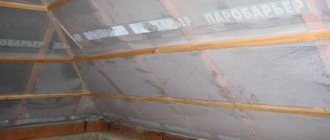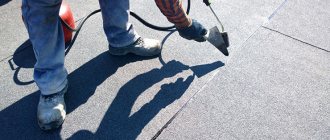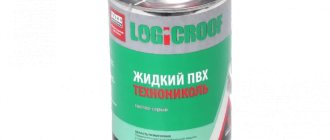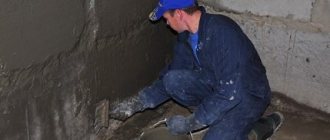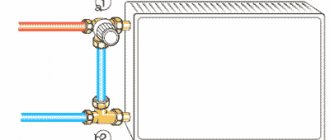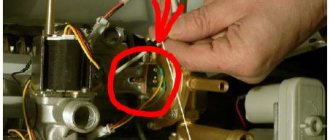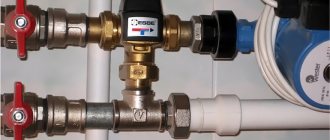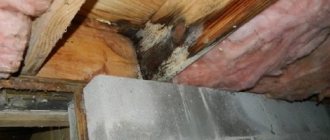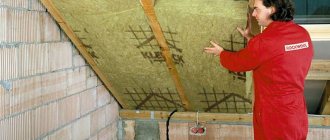There are two types of attic space - a cold attic and a combined attic or attic. In a cold attic, insulation is laid horizontally across the attic floor, and the temperature inside the cold attic is about the same as outside.
The temperature inside a cold attic should not exceed 4 °C outside air temperature (rules and standards for the technical operation of housing stock, decree No. 170 of September 27, 2003, clause 3.3.2), i.e. if the temperature outside is -15 °C, then in the attic it should be no more than -11 °C. If this difference is greater, then, for example, at an outside temperature of -5 ° C, the slope will heat up, the snow on the roof will melt and flow onto the eaves. The cornice will not heat up, because... there is no warm room underneath, and the water on it will turn into ice, forming icicles. The more ice that forms on the eaves, the greater the chance of leaks, the higher the load on the roof and the higher the risk of ice breaking, which can lead to tragic consequences. All this reduces the service life of both the roofing covering and the roof as a whole.
Rice. 1 Ventilation of a cold attic.
To ensure normal temperature conditions in a cold attic, it is necessary, first of all, to insulate the floor between the attic and the living space. The thickness of the insulation is calculated based on several parameters, the main one of which is the location of the house. The second most important criterion for maintaining the temperature regime of the attic space is under-roof ventilation.
In addition to insulation and ventilation, the temperature regime of the attic space is affected by: uninsulated hatch covers for access to the attic, ventilation pipes for rooms (kitchen, bathroom) leading into the attic space, uninsulated hot water supply located in the attic, etc.
The roofing pie for a cold attic can be divided into two parts. The first part is along the floor between the attic and the living space. The second part is along the slope.
The first part of the roofing pie, depending on the type of ceiling, looks like this:
Rice. 2 Pie on the concrete floor.
Rice. 3 Pie on a wooden floor.
The vapor barrier serves to prevent moisture from entering the room into the insulation. On a concrete base, it is best to use bitumen roll material with fused overlaps. A film vapor barrier is used along the joists with the obligatory gluing of the overlaps with sealing tapes. As a vapor barrier, it is necessary to use vapor barrier films D-Folie B, D-Folie B 90 or D-Folie BR.
The insulation is laid in several layers with joints spaced apart to eliminate cold bridges.
The hydro-windproof membrane protects against heat loss and moisture ingress. Moisture can form due to condensation, snow blown into the attic space, and also due to possible leaks. Superdiffusion membranes D-Folie A 150 or D-Folie A 100 must be used as hydrowind protection.
In any case, regardless of the type of ceiling, it is not recommended to cover the insulation on top entirely with plywood or boards. If you occasionally need to walk through the attic space, it is better to provide paths from boards without covering all the insulation.
The second part of the roofing pie using flexible tiles in a cold attic looks like this:
Rice. 4 Roofing pie for a cold attic.
dockpie.ru
How to arrange a roofing pie under a soft roof: general principles and analysis of construction options
To an uninitiated person in the intricacies of construction, the roof appears in the form of an accessible coating that protects his household from weather adversity. In fact, this is a complex structure, each element of which must flawlessly perform the work assigned to it. The components are laid in layers like a culinary product that shares its name with the roofing system. Layers are laid in a certain order, violation of which threatens a noticeable decrease in consumer characteristics. The service life of the roof and the heating technology of the house as a whole depend on how correctly the roofing pie is constructed for a soft roof.
Types of soft roofing structures
Roofing pie is a generalized technical term that combines a number of structures with a similar “layered” structure. The combination of layers should protect the home owners from atmospheric attacks and protect the internal filling of the pie from premature deterioration.
The standard structure of a roofing pie includes the following required components:
- Vapor barrier. Prevents the penetration of vapors from the interior of the house and the condensation of moisture on the building materials used in the construction of the roof;
- Thermal insulation. Helps retain heat, protects against noise, winds, and cold temperatures coming from outside;
- Waterproofing. Prevents the penetration of rainwater and melted winter precipitation into both the roof structure and the building;
- Decorative coating that simultaneously performs the work of wind protection.
The category of soft roofs includes materials with excellent waterproofing qualities. These include bitumen roll representatives, piece analogues, mastics and a new generation of membranes. A couple of decades ago they served only as a barrier against water, but now they also successfully play the role of decorative coatings. This is due to the improved external surface and the development of installation methods that allow super-thin materials to be attached to any type of base.
The combination of insulating and decorative properties has made it possible to reduce the number of main layers in a roofing pie to 3, if one of the types of rolled materials is used for arranging the roof.
When laying bitumen shingles, waterproofing is not completely abandoned. However, it is laid as an additional waterproof layer and covers the roof either completely, if the slope of the slopes does not exceed 18º, or partially in strips along the overhangs, along the ridge and valleys, around pipes and at junctions on roofs with slopes steeper than 18º.
The above list of main roofing layers has the nature of general recommendations. In fact, it is modified by reducing or adding functional elements, because the scheme for forming an ideal roofing structure is influenced by a number of significant circumstances, such as:
- type and purpose of the object being developed, i.e. is it a residential building or a domestic structure;
- temporary or permanent use, determining the use or rejection of thermal insulation;
- the shape of the roof and the steepness of its slopes, directly related to the choice of materials for the roofing;
- type of base for installing a pie and laying a soft roof;
- the presence of an exploited or unexploited attic;
- regional climatic features, according to which the thickness of thermal insulation is determined;
- compatibility of construction layers, because in case of incompatibility, separation or migration layers will be required.
A well-designed soft roof pie is constructed taking into account the entire range of the listed conditions. Without information about the specifics of the project, no one will give exact recommendations, but it is worth familiarizing yourself with the principle of construction, regardless of whether you will build the cake yourself or hired roofers will do its installation.
Principles of constructing a roofing pie
Let's look at the most common pie designs for soft roofing used in private construction. Flat and low-slope roof structures are rarely built over low-rise buildings. However, there are adherents of the strict cubic forms of the techno or high-tech style, and their numbers are steadily growing. Most often, flat roofs are erected over bay windows, attached terraces, utility compartments of the building, garages, etc. They are covered with bitumen-polymer materials or a membrane, laid on reinforced concrete floors or a base made of galvanized profiled sheet.
The most popular in private construction is bituminous shingles, used in the construction of pitched roofs with a slope of 12º or more. It is used mainly to cover truss systems erected over dachas and country houses. Let's start with it.
Roofing pie for flexible tiles
Soft tiles are used to cover buildings with cold attics and houses with insulated attics, the designs of which, of course, have radical differences. In the first case, there is no need to use insulation, in the second, thermal insulation is a mandatory component. Both options require a continuous sheathing made of antiseptic-treated boards, sheets of moisture-resistant plywood or OSB-3 oriented strand boards.
The simplest non-insulated option
The scheme for laying a soft roof over an uninsulated attic is extremely simple:
- a counter beam installed across the rafters is nailed to the rafter legs. The recommended size of the beam is 50x50; it is attached with two rough nails to each rafter beam. The installation pitch of the counter beam depends on the pitch between the rafters. If the standard distance is 0.7-0.9 m, the block is nailed after 30 cm;
- slabs of continuous sheathing are laid on the counterbeam in a staggered manner so that there are no cross-shaped connections between them. The edges of the slabs should rest on the counter-lattice elements. Fasten the slabs every 15 cm with rough nails to the block;
- A self-adhesive waterproofing carpet is laid, the installation of which is carried out depending on the steepness of the slopes. When the slope is 18º or more, only the slopes, ridge, valleys, junction areas and pipe passages through the roof are covered with waterproofing. Less steep roofs are completely covered with an insulating carpet;
- Soft tiles are installed on top of the waterproofing barrier.
If a continuous sheathing is constructed from boards, then the need for a counter-lattice is automatically eliminated. The boards are fastened directly to the rafter legs and laid with a gap of 3 mm between the elements.
Installation of an insulated roof
The pie for an insulated roof is much more complicated. Its design is complemented by thermal insulation. And if it exists, then you will need a vapor barrier material that protects the insulation from moisture accumulation. The result of moistening is a decrease in insulating characteristics and the accompanying processes of rotting with subsequent destruction. Ventilation is also needed to remove condensation from under the roofing, which is unable to pass drops dangerous to wood on its own.
The layout of layers of roofing pie for an insulated pitched roof, which involves the use of an attic, is as follows:
- On the inside of the rafter system, a vapor barrier membrane is attached directly to the rafters with a stapler. It is laid parallel to the overhangs in strips from bottom to top. The strips are connected into a single web with double-sided tape;
- Once the vapor barrier has been installed, a counter-lattice is constructed from the bar, again from the inside, the installation step of which depends on the material of the planned internal lining of the attic. For example, under plasterboard sheathing, it is advisable to place the sheathing bars at a distance of 40 or 60 cm;
- On the outside of the roof, auxiliary struts are mounted between the rafter beams. They are required to hold the insulation boards. The spacers are placed in increments of 2-3cm smaller than the height of the insulating board. So it is necessary that the thermal insulation is firmly fixed in the compartments created for it, “straightening out” after slight compression during the installation process;
- The resulting semblance of a honeycomb is filled with heat-insulating material, the thickness of which should be 3-5 cm less than the thickness of the rafter legs. This is a necessary condition for proper ventilation of the roofing pie;
- the counter-lattice is constructed again. It is nailed to the rafters along their direction to form ventilation ducts - roof vents;
- a continuous sheathing is attached to the outer counter-lattice, on top of which an additional waterproofing carpet is laid;
- soft tiles are laid.
To install a warm roof with soft tiles in the northern regions, sometimes the thickness of mineral wool insulation of 15 cm is not enough - a generally accepted standard for the middle zone. Then, on the outside, first a tier of counter beams is installed transverse to the rafters for laying the second layer of insulation, then a beam is installed along the rafters for installation of a continuous counter batten.
If you plan to lay bituminous shingles on top of low slopes constructed from reinforced concrete slabs or arranged by raking and pouring a cement-sand screed on top, the vapor barrier is laid on a concrete or cement-sand surface. On top of the vapor barrier, a board is installed on the edge in increments of up to 90 cm, and then the required number of tiers of counter-lattice.
Roofing pie with wooden elements cannot be closely adjacent to chimney pipes. The required distance from the pipe walls can be found in SNiP 41-01-2003. The empty space is filled with non-flammable mineral wool material, and an apron made of galvanized or laminated metal is installed outside around the pipes.
The video will present the stages and principles of constructing a roofing pie under soft tiles:
Roofing pie for rolled materials
For the construction of roofs with a slight angle of slope, with a spread from 1º to 12º, bitumen-polymer materials or roofing membranes are used. It just doesn't make much sense to install custom shingles on them. And the patterned aesthetics of flexible tiles on flat and almost flat roofs will delight only birds.
There are no significant differences in the set of layers for piece and roll material. The sequence is similar: vapor barrier → insulation → hydrobarrier - also a decorative coating and wind protection. However, the installation of a roofing pie has its own specifics. Continuous sheathing and counter beams are not used. The layers are laid without auxiliary wooden elements on concrete floors, cement-sand screeds, corrugated sheets, prefabricated leveling structures. Therefore, we focus attention not on the sequence of installation actions, but on the installation features.
Principles of vapor barrier design
The following materials serve as a vapor barrier layer for laying roll materials:
- bitumen and bitumen-polymer vapor barrier, fused onto a concrete or cement-sand base, including cement-sand insulation with vermiculite, expanded clay, perlite in the form of filler in case of a slope slope of more than 6º. If the slope is less, bitumen vapor barrier can be laid without gluing or fusing to the base.;
- polyethylene reinforced or non-reinforced vapor barrier, laid loosely along the corrugations of the profiled sheet or glued to it if the slopes are inclined more than 6º.
In the construction of a soft roof using prefabricated screeds made of plywood or OSB boards, any type of vapor barrier material can be used, but the recommended option is a bitumen-polymer vapor barrier with a polyester fabric base. However, it is also not forbidden to place polyethylene on a concrete surface, but before this you should create a separating layer of glassine.
The vapor barrier layer is laid in the form of a kind of pallet extending onto the vertical planes of adjacent walls and parapets. The height of the sides of the pallet is calculated as follows: the thickness of the thermal insulation layer plus 3-5 cm. Similar sides are installed around the intersection of the roof with chimney pipes and other communications.
Both vapor barrier options must be combined into a continuous sheet. Strips of bitumen and bitumen-polymer material are laid with an overlap of 8-10 cm on the sides and 15 cm at the end joints and welded with a gas torch. The connection of polyethylene strips is made using adhesive tape.
Rules for laying thermal insulation
You can insulate a soft roof with a roll covering using literally any material, but mineral wool boards and foam polystyrene are considered priority. On concrete bases and cement-sand screeds, the insulation system is laid in one tier, on corrugated sheeting in two so that the joints of the elements of the upper row are not located above the joints of the lower layer.
The hardness of mineral wool for single-layer insulation is 40 kPa with a compressibility of 10%. To construct two-tier thermal insulation, it is not necessary to use slabs with equal rigidity. The bottom row can be folded with material with a strength rating of 30 kPa, the top row 60 kPa.
If a polymer membrane is used as a waterproofing and decorative roofing covering, a separating layer of fiberglass or geotextile must be laid between it and the polystyrene thermal insulation. Otherwise, the membrane will lose its consumer qualities before the time guaranteed by the manufacturer due to the gradual migration of plasticizers into the adjacent material. A separating layer is also required when installing an inversion ballast roof if the polymer coating is laid on a bitumen vapor barrier layer.
Laying mineral wool slabs on corrugated sheets without first constructing a prefabricated screed from plywood or OSB sheets can be done if the thickness of the thermal insulation is twice as large as the distance between adjacent corrugations. If reality does not meet this condition, a prefabricated screed is constructed before laying the insulation.
The installation of thermal insulation under a roll covering requires compliance with the following rules:
- the thermal insulation material is attached separately from the covering laid on top;
- with the mechanical fastening method, each thermal insulation slab and its individual part is fixed at two points. The insulation is fastened to the corrugated sheet using steel self-tapping screws with a plastic sleeve in the shape of a fungus. Plastic bushings are not used if the slope of the slopes is more than 10º. In any case, they are attached to the concrete base with screws with dowels and metal plates;
- The insulation boards are glued to bitumen-polymer mastic. Gluing is possible if the area of the surface “planted” on the adhesive composition is at least 30% of the area of the insulating board;
- Insulation boards are laid with mandatory seam spacing so that weak areas are distributed evenly. Elements of the second tier, if there is one, are shifted relative to the first by at least 20 cm, both along the side and end lines;
- seams in insulating carpets wider than 5mm must be filled with heat-insulating material.
The use of rigid insulation is justified economically and technologically. It allows you not to install a screed on top of the insulation, which is mandatory for fill-in thermal insulation.
If it is necessary to construct a roof slope to completely free the surface from atmospheric water and dirt, the thermal insulation is supplemented with slope-forming devices. Most often they are made from wedge-shaped slabs of mineral wool or from similar polystyrene foam parts, less often from backfill insulation followed by pouring a cement screed. A slope on a concrete base can also be done by pouring cement and sand, which is unacceptable for forming a slope on a base made of a profiled sheet.
Additional layers of roofing material
An additional barrier against atmospheric water is installed in areas of high load. It is laid in strips along the ridge, overhangs and junctions with fillets constructed in advance, in valleys, around penetrations and points of internal drainage. It is constructed either from strips of bitumen-polymer roofing coating, or from a special self-adhesive hydrobarrier.
The construction of the roofing pie is completed by laying the rolled covering and fixing it by fusing, gluing or fastening with self-tapping screws with bushings or plates.
The presented schemes for constructing a roofing pie do not contain precise recommendations. We have provided general rules, taking into account which will ensure flawless operation and long service life of the roof in the middle zone. In the case of construction in northern latitudes, the proposed options require modification.
krovlyaikrysha.ru
Roofing pie device
All layers of the roofing pie with metal tiles are installed according to clear instructions.
Lathing
The base for metal tiles is assembled from boards 10 cm wide and 2.5 or 3 cm thick. The second size does not play a special role, since in any case it will not cause excessive pressure on the roof, because 1 m² of metal tiles weighs only 7 kg.
A relatively thin sheathing combined with metal tiles will definitely not break under the weight of the snow mass. Troubles can only arise in a situation where the structure is assembled from boards of different thicknesses. Permissible deviation is 2–3 mm.
The sheathing is constructed from boards of medium width, because they can distribute the load well.
Three types of sheathing can serve as a place for attaching metal tiles:
- stepwise (frequent), during which the boards are placed so that between their centers there is an interval equal to the wavelength of the finishing material;
- solid, mounted with tiny gaps of 2–3 cm only on a roof inclined by 14–20°;
- combined, combining sparse and continuous sheathing, with the first being laid out over the entire roof area, except for weak points such as the junction of the roof with the chimney or the valley.
Under the metal tiles, both a sheathing with a relatively large step and a solid wooden flooring with gaps of 2–3 cm are made.
In most cases, for the installation of metal tiles, a step wooden base is used, which can be easily constructed on roofs of various configurations with a slope of more than 20°.
To make a sparse sheathing for metal tiles, you need to complete several tasks:
- Place the first two boards (on the roof eaves) 5 cm closer to each other than all other elements of the sheathing.
Two cornice boards are laid close together, and other sheathing elements are fixed to the frame at large intervals. - Attach the remaining boards to the rafters at regular intervals.
- Drive 2 nails with a diameter of 3 mm and a length that would allow the fasteners to go deep into the center of the frame beams into the places where the sheathing elements come into contact (closer to their center) with the rafters.
Countergrid
The construction of the counter-lattice is carried out after the waterproofing material is spread on the rafters. This layer of roofing pie under metal tiles is created from wooden slats with a cross-section of 5x5 cm.
With a thickness of 5 cm, the counter-lattice can provide complete ventilation of roofing materials. Excess condensation will evaporate, and this is good for both cold and warm roofs.
In order for a counter-lattice to appear on the roof frame made of metal tiles, the following measures should be taken:
- Please note that the structural elements must be laid out in increments equal to the width of the span in the rafter system.
- Attach wooden slats of the required length to the rafters on top of the waterproofing film.
The counter-lattice is fixed at the points of contact with the rafters - Screw self-tapping screws into the counter-lattice elements (at a distance of 30 cm from each other).
- To install the ridge, file the edges of the upper beams so that they can tightly connect to the opposite structural elements.
What is an attic
The attic space is limited by the roof slopes and the ceiling of the residential floor. This place is often used to create additional living space.
There are two types of attics in private households:
- Residential . It is called an attic. It can be equipped with a living room, study, bedroom, library, etc. The height of the room in this case should be at least 220 centimeters. In addition, it is necessary to provide ventilation, natural lighting, and insulate the slopes.
- Non-residential . Such attic space is usually used to house technical equipment and store old or unnecessary things. In this case, a 2-meter height will be sufficient, and there is no need to provide natural lighting. Instead of insulating the slopes, they insulate the attic floor.
When making a decision to repair or rebuild a house, you need to decide in advance for what purpose the attic will be used in order to make calculations and a design for the floor. The list of necessary materials and the gap between the beams depend on this. They must provide the required strength and load-bearing capacity.
Functional purpose of floors
The design of the attic floor depends on the parameters of the structure and the purposes for which it is planned to use the under-roof space. The attic functions as a kind of air gap that separates the cold roof from the heated floors.
The floor in the attic performs a number of tasks:
- carrier _ The floor, located between the upper residential floor and the attic space, is assigned a load-bearing function, so it is made reliable and durable, since people will move on it, they plan to place equipment on it and arrange storage areas;
- insulating _ In a cold attic, the temperature differs little from that outside the house. In this case, the floors in the attic have a thermal insulating function, thereby preventing the air from cooling on the residential floors. To retain heat, the attic floor needs to be insulated. It is advisable to entrust such work to professionals.
What to do with a complex roof shape?
Let's tell you frankly: metal tiles are far from the best roofing material for a roof with a complex shape. Therefore, since there is already one and it needs to be insulated, be sure to think about the ventilation of all its parts. Definitely everyone!
The fact is that certain areas without ventilation will be warmer; snow will melt on them and flow down to the eaves, where there is ventilation and the roof covering has a lower temperature (especially on the overhang, under which there is no insulation). And with metal tiles for water, it’s not difficult to find an entrance to the under-roof space.
Further, the melted snow will encounter unmelted snow and remain there, eventually turning into ice. And putting it on is not only a danger for people living in the house when they go outside at the wrong time - it is also a constant destruction of the drain.
This is why the ventilation of a complex roof must be 100%, without missing a single section. To do this, install an intermittent counter-lattice, which allows air flows to move not only in one specific direction, but also in different directions, reaching all zones. Also, a couple of additional aerators will not be superfluous.
And after finishing the insulation, also make sure that the air intake hole in the eaves is always open. It cannot be hemmed with a board, but it can be covered with a slightly bent gutter drip.
As a last resort, we advise you to insulate such a roof from the inside using polyurethane foam, which penetrates into all cracks and hard-to-reach places (and a complex roof always has them), and is not afraid of moisture:
Features of the device and design of floors
Since attic floors perform two functions - load-bearing and insulating, they have a multi-layer structure. Each of the elements of the “pie” complements each other, which ensures the created structure has a long service life, strength and the ability to withstand heavy loads.
The construction of the floor in the attic requires the presence of the following layers:
- Finish floor . This name is given to the floor covering, which is laid on a rough base. If it is an attic, then when installing the finished floor, linoleum, laminate, parquet, etc. are laid. In non-residential premises there may be no finishing floor covering.
- Rough base . It is a boardwalk that is mounted on logs. The subfloor is lined with edged boards 4–5 centimeters thick or, to save money, with unedged boards.
- Lags . These are strong, level pieces of wood that are laid perpendicular to the floor joists to create a floor covering. When installing an attic floor on wooden beams, insulation is placed between the joists, which is protected from below with a layer of vapor barrier, and covered with waterproofing material on top. If you do not use insulating layers, then repairs will be required in a few years.
- Beams . The frame of the floors is built from thick and strong beams, which are either mounted on the projections of the walls or built into them. They must support the entire weight of the structure.
- Ceiling trim . On the side of the rooms, the floors are decorated with finishing materials, for example, natural wood or plasterboard.
Hatch to the attic
You can install two types of hatches in the frame attic. We will build the first hatch with our own hands, and the second one will be purchased. In any case, installing a hatch is a good design decision, since it is not as large as a ladder. The hatch can be folding and fits perfectly into the interior.
On a note.
In order to install a hatch in the attic in a private house with your own hands, you must first decide on the location. It is recommended to place the hatch between the floor beams.
- The lid should open easily so that nothing obstructs it, both from the outside and from the inside.
- The color and appearance are selected in such a way that it fits harmoniously into the interior.
- An ordinary non-folding ladder, like a hatch, should not interfere with movement and fit into the interior.
The hatch must meet the following criteria:
- Comply with the overall design;
- Simplicity of design, thanks to which self-assembly is possible;
- The product must meet all standards - strength, reliability, durability;
- The presence of a door with insulation;
- Ease of use.
Types of attic floors
To construct the ceiling of a cold attic, materials differing in weight, durability, cost and load-bearing capacity are used.
There are several types of floors depending on what they are made of:
- Wooden elements . For their manufacture, you can use beams with a cross-section of 150x150 or 200x200 millimeters. The advantage of this option is that wood is quite durable and at the same time relatively light material, so wooden elements do not put additional load on the foundation of the house. In addition, their big advantage is their low price and availability. But such an attic floor is used when the size of the building does not exceed 6-10 meters, since this is the maximum length of lumber.
- Metal products . Metal I-beams are distinguished by their strength and ability to withstand heavy weight without deformation. But they weigh a fair amount, so they are rarely used in wooden houses, but for brick and aerated concrete buildings they are the best option.
- Reinforced concrete products. Molded floor beams, made from reinforced heavy-duty concrete, are used for multi-story buildings, since they are heavier and the same length.
Of all the above types of floors, in private low-rise housing construction, in most cases, preference is given to wooden beams. They have the optimal balance between price and quality. If the calculations are carried out correctly and the technology is followed, repairs to the ceiling will not be required in the coming years.
Features of ventilation of a cold roof made of soft roofing
When installing a cold roof, additional measures are taken to ventilate the attic:
- in wooden houses with gable roofs, the boards on all gables are not tightly fitted, air penetrates through the cracks. This method is simple to implement, but it is not suitable for houses with stone/brick gables, as well as for hip roofs, which do not have gables at all. Another disadvantage is that rainwater penetrates into the cracks along with the wind;
- ventilation holes are made in stone and brick gables. Their total area is 0.2 percent of the area of the attic itself, otherwise it will not be enough for proper ventilation. Ventilation grilles are placed with the holes down so that rainwater does not flow into the attic;
- For hip roofs, one ventilation hole is located in the eaves lining, the second - at the ridge. Loosely fitted boards or perforated plastic soffits can be used as filing;
- Hip and round roofs do not have a ridge. Here you will need to install point aerators.
I have already written in more detail about ventilation of soft roofs in one of the articles. You can get to know her here.
Requirements for the device of the pie
Since the safety of staying in the house depends on the quality of installation and repair of attic floors, a number of requirements are imposed on their arrangement.
In order to know the maximum permissible load that the structure can withstand, it is necessary to perform the appropriate calculations, and then, based on their results, they begin to develop a project from which it will be clear how to properly insulate the attic floor in the house.
The requirements relate to:
- Load-bearing capacity . It directly depends on the material used to make the beams and the gap between them.
- Distances between load-bearing elements . The maximum permissible value for this parameter in accordance with building codes is 4 meters.
- Resistance to temperature changes . It is necessary that the beams can withstand such changes without problems. The fact is that the difference between the air temperature in the residential floors and in the attic always exceeds 4 degrees.
- Isolation . The attic floor covering of a cold attic should protect the premises of the household from the penetration of cold and moisture from the under-roof space.
During the design process, you should take into account the requirements for the beams used to arrange the floor in the attic so that the result is reliable and durable. The distance between them must be calculated based on the loads exerted on them.
What is a roofing pie for metal tiles?
Roofing pie made from materials for metal tiles
Roofing pie made from metal tiles is a multi-layer structure, the purpose of which is to protect the building from precipitation, extremely high and low temperatures, loud street sounds, dust, small animals and insects. The metal roofing pie should provide effective ventilation and prevent air stagnation in the space under the roof.
These functions are ensured by the competent selection and correct installation of various technological materials in a strictly defined sequence. Each layer performs a specific task, and the entire structure works like a well-oiled machine. If you look at a cross-section of a roofing pie for metal tiles, it will look like a sandwich with components of different types and sizes.
Technology for creating an attic floor using wooden beams
If you have experience in construction work, you can install the ceiling of a cold attic using wooden beams yourself. This process is performed at the final stage of roofing work.
The sequence of actions will be as follows:
- Installation of load-bearing beams. For a small private house, wooden floors made from timber with a cross-section of 150x150 or 200x200 millimeters are suitable. They are laid on concrete or brick walls.
- Installation of lag. They are placed on the edge perpendicular to the beams in increments of 60 centimeters. The logs are made from boards with a cross section of 150x50 millimeters.
- Laying thermal insulation. The insulation is placed between the joists - it will protect against the penetration of cold from the attic.
- Installation of rough and finished floors.
- Covering load-bearing beams on the side of the room to decorate the ceiling surface.
When insulating the attic floor, you should not forget about installing hydro- and vapor barriers.
kryshadoma.com
Cold attic design
When building the roof of a house, many people think about making a cold attic or attic underneath it? The easiest way to organize a roof is with a cold attic space. Construction of an attic will cost several times more and require more labor.
. Although, it is undeniable that the attic will significantly expand the living space.
Cold attic roofs have the following main components in their pie:
:
- roofing;
- attic external walls (applicable for gable roofs with gables);
- insulated ceiling between the living space and the attic.
Ventilation is provided by eaves and ridge vents. The air passing through the eaves openings is called supply air, and the air leaving through the ridge is called exhaust air. Additionally, ventilation can be done through dormer windows on the gables or roof slopes. The windows are equipped with louvered grilles to allow the ventilation intensity to be adjusted.
Dormer windows are located on opposite slopes of the roof so that there are no unventilated areas.
Dormer windows can be rectangular, triangular and semicircular in shape. Their lower part should be at a height of no more than 0.8-1.0 m from the floor of the attic, and the upper part should not be lower than 1.75 m from the floor in the attic. They can also serve as an exit to the roof of the house to inspect the roof, ventilation and chimney elements.
Roof type with metal tiles
If the attic of the house is planned to be used as a living space, then the metal tile roof will need to be insulated. And if you want to leave the space above the ceiling completely empty, you can make the roof cold.
Insulated roof
A roofing pie with insulation has the following positive characteristics:
- reduces the audibility of extraneous sounds in the house;
- helps create an ideal microclimate in the house;
- allows you to create a living room under the roof.
When installing a warm roof, insulation and a vapor barrier film are placed under the metal tiles.
When installing a warm roof with metal tiles, 7 layers are created, which are arranged in a certain order:
- A vapor barrier that allows steam to escape freely from the building, but does not allow it to enter back.
- Rafters and purlins that form the backbone of the structure.
- Thermal insulation layer inserted into the cells between the rafters and purlins to create a ventilation gap.
- Waterproofing material that protects insulation and other layers of the roofing pie from moisture.
- A counter-lattice, which fixes the waterproofing film, being installed parallel to the rafters.
- Sheathing made of beams located at a distance of 35–45 cm from each other in a direction perpendicular to the rafters.
- The finishing roofing material, that is, metal tiles.
Unfortunately, insulation as part of a roofing structure can turn from a plus into a big minus. If suddenly for some reason, for example, due to an error in the construction of the roof, the thermal insulation material absorbs moisture, then the value of the warm roof will be lost.
Video: construction of an insulated metal roof
https://youtube.com/watch?v=Cp5O0W3ADSo
Cold roof
A cold-type roof with metal tiles as a finishing coating is considered a simple structure.
When constructing a cold-type roof, only waterproofing material, sheathing and counter-lattice are placed under metal tiles
Cold roofing cake consists of only 4 layers:
- Frame made of rafters.
- Film waterproofing, secured either with small nails or with a construction stapler with a sag of 1 to 2.5 cm.
- A counter-lattice fixed with self-tapping screws and holding the waterproofing material in place.
- Lathing that serves as the basis for attaching sheets of finishing coating.
- Metal tiles.
A cold roof with metal tiles will not suit every owner of a private building. In heavy rain, you can’t help but compare a roof without insulation to a drum.
Steam and thermal insulation of a cold attic
For a roof with a cold attic, it is most important to minimize heat loss through the attic floor
. For both wooden and reinforced concrete floors, a vapor barrier is mandatory. It is laid on the ceiling itself and protects the insulation from vapors that can condense in the heat insulator after passing through the ceiling of the living room. Slab and bulk materials can be used as insulation. The ceiling pie consists of a vapor barrier, floor beams and insulation.
The following types of heat insulators are often used in ceiling coverings:
:
- expanded polystyrene and foam boards;
- mineral wool slabs or mats;
- expanded clay granules;
- fuel or granulated slag;
- sawdust with lime or clay;
- pumice.
The thickness of the required insulation layer is selected depending on the estimated winter temperature using the table below.
Winter temperatures are calculated according to SNiP 2.01.01-82 (building climatology and geophysics) or selected by regions of the Russian Federation from the corresponding climate maps.
The insulation is laid between the joists or ceiling beams, and a boardwalk is made on top for the attic passages. Joists are usually 50 mm thick, and decking boards are 25-35 mm thick.
For ventilated attic spaces, soft or semi-solid heat-insulating materials are considered the most optimal.
Attic waterproofing device
Waterproofing roofs with a cold attic, according to many experts, is a controversial issue. Some say that waterproofing must be present under the roofing material, while others categorically recommend that it be abandoned. Here, a lot depends on the type of roofing material and the angle of inclination of the roof slopes.
Metal roofs are most susceptible to corrosion, which occurs due to possible small leaks or condensation
.
Therefore, we once again draw your attention to the fact that ventilation plays one of the main roles in the fight against condensation.
.
For flat metal roofs, experts recommend installing superdiffusion membranes. It will prevent moisture from entering the outside of the roof when snow or rain blows in. No matter how well the roof is laid, there is always the possibility of minimal leaks. That is why, by paying a little extra, you will receive additional protection from moisture getting on the insulation in the ceiling of a cold attic.
Possible leaks or condensation entering hydrophobic insulation materials significantly reduce their thermal insulation properties.
If, for example, slate is used as a roofing material, then waterproofing can be abandoned. There is also corrugated sheeting with an anti-condensation coating on the market, which can hold up to 1 liter of water per 1 m2. For our part, we recommend always using waterproofing membranes, because this is the cheapest and easiest additional way to protect your roof from possible leaks
.
When installing waterproofing membranes, a counter-lattice is used. It serves as a fixing strip and, due to its height, provides the necessary clearance for ventilation of the under-roof space. The installation of lathing in a cold attic is no different from insulated roofs. The dimensions of the sheathing and its pitch determine the type of roofing being installed.
Cold attic temperature
To prevent ice and icicles from forming on the roof, it is necessary to maintain the correct temperature and humidity conditions in the attic. If the thickness of the thermal insulation material is insufficient, significant heat losses occur through the ceiling. Warm air, heating the roof covering, causes snow to melt and ice dams to form. By choosing the right insulation layer, this can be avoided.
The effectiveness of a heat insulator can be assessed by measuring the temperature of the top layer of insulation. The electronic thermometer is immersed in insulation by 10-20 mm. The temperature readings taken should correspond to the values in the table below.
As you can see, the design of a cold attic pie is not particularly complex in design. The main task is to ensure the necessary intensity of ventilation and the thickness of the thermal insulation layer in the ceiling.
vseokrovle.com
Installation of a cold roof made of soft tiles
The basic rule for cold attics does not depend on the covering: a full-fledged cake is made in the attic floor, otherwise the house will be cold.
note
There are more options for insulation on the ceiling than on a pitched roof: expanded clay or sawdust-clay mixture can be used as a heat insulator.
The layer will be thick, but for an unused attic this does not matter much. But it's cheap. Otherwise, the cake is made according to all the rules: vapor barrier, waterproofing, and the floor is covered with boards on top.
The second feature concerns ventilation. Here the differences in materials are already affecting. Soft roofs (unlike profile metal) do not have waves that serve as ventilation. The bitumen coating is completely sealed and does not breathe.
note
A ridge aerator for flexible tiles should be installed in any case; this does not depend on the roof structure or its insulation.
Otherwise, the technology of a cold roof made of soft tiles differs from that of an insulated one: on cold roofs, a continuous sheathing can be laid directly on the rafters (without counter beams). The entire attic serves as a ventilation gap. The sheathing and rafters are not covered from the inside.
